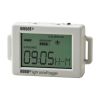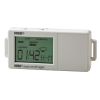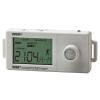HOBO UX90 State Data Logger
Features
- One logger with four recording modes
- Internal reed switch can be used to determine when a door or window is open or closed
- Compatible with a wide range of external sensors
- Expedited repair and warranty service
- Lifetime technical support
- More
Overview
Records state changes, electronic pulses, and mechanical or electrical contact closures from external sensing devices. Ideal for monitoring energy consumption, mechanical equipment operation, and water and gas flow. The Onset HOBO UX90 state logger is compatible with a wide range of external sensors, and operates in an indoor environment.
Memory
The HOBO UX90-001 State Data Logger is available in a standard 128 KB memory model (UX90-001) capable of 84,650 measurements and an expanded 512KB memory model (UX90-001M) capable of over 346,795 measurements.
Measurements Supported
- Event
- Kilowatt Hours (kWh)
- Motor On/Off
- Pulse Input
- Runtime
- State Open/Closed
- Water Flow
| Internal Sensor | |
| Maximum State, Event, Runtime Frequency |
1 Hz |
| Preferred Switch State |
No magnet present (normally open) |
| External Input | |
| External Contact Input |
Electronic solid state switch closure or logic driven voltage output |
| Range |
0 to 3 V DC (USB powered), 0 to 2.5 V DC (battery powered) |
| Maximum Pulse Frequency |
50 Hz |
| Maximum State, Event, Runtime Frequency |
1 Hz |
| Pulse, Event Lockout Time |
0 to 1 second in 100 ms steps |
| Solid State Switch Closure |
Input Low: < 10 KΩ; Input High: > 500 KΩ |
| Internal Weak Pull-Up |
100 KΩ |
| Input Impedance |
Solid state switch closure: 100 KΩ pull up |
| Logger | |
| Resolution |
Pulse: 1 pulse, Runtime: 1 second, State and Event: 1 State or Event |
| Logging Rate |
1 second to 18 hours, 12 minutes, 15 seconds |
| Memory Modes |
Wrap when full or stop when full |
| Start Modes |
Immediate, push button, date & time, or next interval |
| Stop Modes |
When memory full, push button, or date & time |
| Power Source |
One 3V CR2032 lithium battery and USB cable |
| Battery Life |
1 year, typical with logging intervals greater than 1 minute and normally open contacts |
| Memory |
UX90-001: 128 KB (84,650 measurements, maximum) UX90-001M: 512 KB (346,795 measurements, maximum) |
| Download Type |
USB 2.0 interface |
| Full Memory Download Time |
10 seconds for 128 KB; 30 seconds for 512 KB |
| Logger Operating Range |
Logging: -20° to 70°C (-4° to 158°F); 0 to 95% RH (non-condensing) Launch/Readout: 0° to 50°C (32° to 122°F) per USB specification |
| LCD |
LCD is visible from: 0° to 50°C (32° to 122°F); the LCD may react slowly or go blank in temperatures outside this range |
| Size |
3.66 x 5.94 x 1.52 cm (1.44 x 2.34 x 0.6 in.)
|
| Weight |
23 g (0.81 oz)
|
| Environmental Rating |
IP50 |
- HOBO UX90-001x State Data Logger
- 2.5 mm input cable
- Command strip
- Double-sided tape
- Hook & loop strap
- Magnet with 2 screws
In The News
Supplying Seattle’s Drinking Water: Using Data Buoys to Monitor the Cedar River Municipal Watershed
Providing clean, safe, and reliable drinking water for the 1.6 million people in the greater Seattle area is a top priority for Seattle Public Utilities (SPU). With limited water supplies, SPU dedicates considerable resources to maintain its watersheds and mountain reservoirs. About 70 percent of Seattle Water comes from the Cedar River Municipal Watershed , and the other 30 percent comes from the South Fork Tolt River Watershed . [caption id="attachment_39574" align="alignnone" width="940"] Data buoy in Chester Morse Lake. Data buoy in Masonry Pool. (Credit: Kevin Johnson / Seattle Public Utilities) [/caption] Jamie Thompson, a fisheries biologist at SPU, monitors aquatic ecosystems centered on fish listed under the U.S. Endangered Species Act (ESA).
Read MoreData-Driven Advocacy on the Lower Deschutes River
Like many freshwater environments, the Deschutes River in Oregon is under pressure from development, pollution, and climate change. Many rivers, streams and lakes in the Deschutes Basin do not meet Oregon water quality standards –where state water quality monitoring assesses levels of bacteria, pH, dissolved oxygen, temperature, and fine sediment. Hannah Camel is the Water Quality Coordinator for the Deschutes River Alliance (DRA), a non-profit organization that focuses on the health of the lower 100 miles of the Deschutes River–the area most affected by human intervention. As a data-driven organization, the DRA has benefited from the installation of two NexSens X2 data loggers.
Read MoreExpanding the Port Everglades: Real-Time Monitoring of Water Quality Conditions from Planned Dredging Operation
The Port Everglades in Broward County, Florida, serves large trade vessels and cruiseliners and incoming and outgoing recreational boaters. However, as cargo ships become larger, the port must expand. A dredging project led by the US Army Corps of Engineers will substantially deepen and widen the port's navigation channel to accommodate larger Panamax cargo ships and modern cruise liners. As a result of this project, a large amount of sediment will be displaced into the water column. This suspended sediment may settle outside of the project area, burying benthic organisms like corals, and possibly carrying harmful particulates to other regions. [caption id="attachment_39497" align="aligncenter" width="2560"] A CB-950 and CB-25 deployed on site at Port Everglades.
Read More















